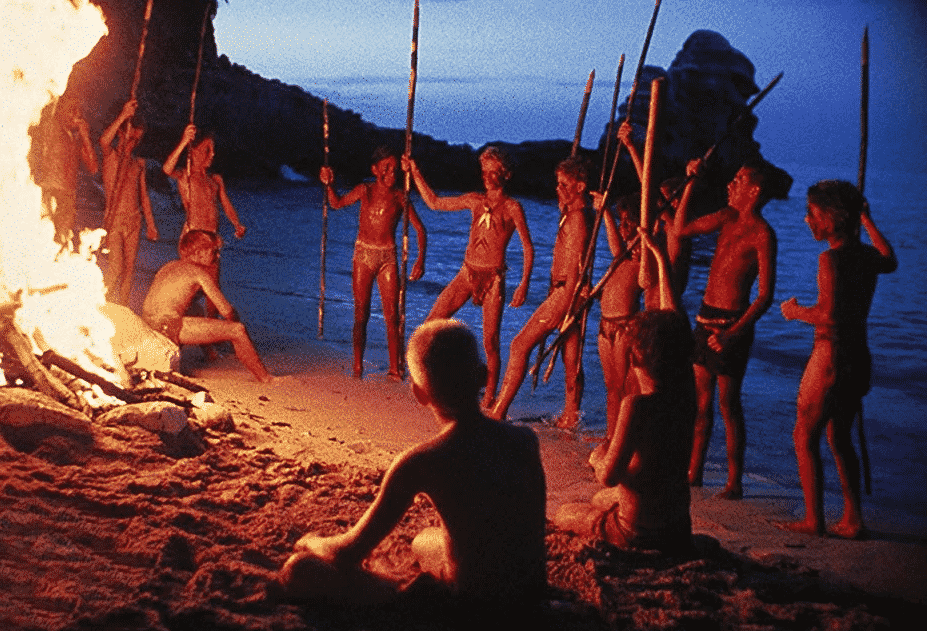In Chapter Nine of Lord of the Flies, the atmosphere on the island is very tense, and the ambiance is mirrored by the weather in Golding’s use of a thunderstorm. As the tension rises and the storm gets worse, the boys start to recite the sinister ‘dance’ they perform when they are killing pigs for meat. Meanwhile, Simon has just discovered an explanation behind the ‘beast’ Samneric saw – it is a fallen parachutist who has died and landed on the island.
He intends to tell this to the other boys, but when he reaches them they are so deeply engrossed in their dance that they claim he is the beast, and Simon is brutally murdered. Simon was a Jesus-like character who represented the benevolence in humanity, so his death signifies the death of goodness on the island.
Simon’s death is a key event in revealing the extent to which the boys in Lord of the Flies have succumbed to evilness. This is made evident by the way Golding crafts them to be reminiscent of the ‘beast’ they all fear, suggesting that the evil they are so fearful of is not a physical being but is inside of them. Golding presents the boys as a single entity of evil by using the quotation ‘throb and stamp of a single organism’ when describing them.
The word choices ‘throb’ and ‘stamp’ have violent connotations, presenting the ‘single organism’ as beast-like which directly links to the ‘beast’ they imagine they are killing. The idea of the boys becoming the beast is continued in the quotation ‘there were no words, no movements but the tearing of teeth and claws’.
The phrase ‘no words’ has animalistic qualities, implying they have become savage, and this phrase highlights how their savagery has reversed their humanity until they are at the same level as animals. Furthermore, the imagery ‘tearing of teeth and claws’ is reminiscent of a beast.
We get the impression the boys are going against nature by murdering Simon as he is a character that appreciated the natural beauty of the island, and many beautiful descriptions of nature are positioned in parts of the novel where Simon is present. This idea is developed by the use of a thunderstorm, which are often associated with destruction and danger. Historically, people used to believe thunderstorms were a sign that God was angry, so Golding’s use of thunder is significant as it portrays Simon as a divine figure with close ties to religion and God, suggesting his murder was not only against nature but against God as well.
This links in with the idea that Simon is a Christ-like character, as throughout the novel he is the one boy who stands out as not partaking in violence and who is kind to everyone regardless of their social status. His benevolent attitude is made clear when he is described as helping get fruit for the ‘littluns’ in the phrase ‘Simon found for them the fruit they could not reach, pulled off the choicest from up in the foliage, passed them back down to the endless, outstretched hands’.
The ‘littluns’ are presented as at the bottom of society and are dismissed by the ‘bigguns’, so it is significant that Simon is willing to help them despite their low social standing. Furthermore, the phrase ‘endless, outstretched hands’ mirrors biblical scenes in which people tried to touch Jesus, further indicating that Simon is Christ-like.
Golding suggests the boys have blemished the island, and this is made evident by the use of the word ‘scar’ to describe the lightning. ‘Scar’ mirrors the language used at the start of the novel, reminding the readers of the plane crash which was referred to as ‘the scar’.
This word choice indicates the boys have wounded the island in a sense, and on a larger scale implies that humanity is a threat to peace and nature. ‘Scar’ evokes connotations of permanence, suggesting the shame of Simon’s murder will haunt the island – and perhaps the boys – forever.
The idea that the boys have gone against nature by killing Simon is emphasized by the huge contrast between their violence and disrespect towards him as opposed to nature’s gentleness after his death. The quotation ‘the water rose further and dressed Simon’s coarse hair in brightness’ highlights nature’s respect as it is symbolic of a crown being placed on his head, presenting him as a king who deserves maximum respect.
Similarly, the ‘brightness’ could refer to a halo, linking in with the idea that Simon is an angelic, Christ-like figure. We get the impression nature is returning the affection he showed it in word choices such as ‘bright’ and ‘dimple’, both of which evoke connotations of a smile.
Overall, Simon’s death displays the extent to which the boys have descended into savagery, and their disrespect to him in contrast with nature’s respect confirms the suggestion that their actions went against nature. The whole scene is somewhat reminiscent of Jesus’ crucifixion on the cross, suggesting Simon gave his life to help the boys even though he saw evil in them – it is true that his last actions were him trying to reassure them that the beast was not real and there was no need to be afraid.

